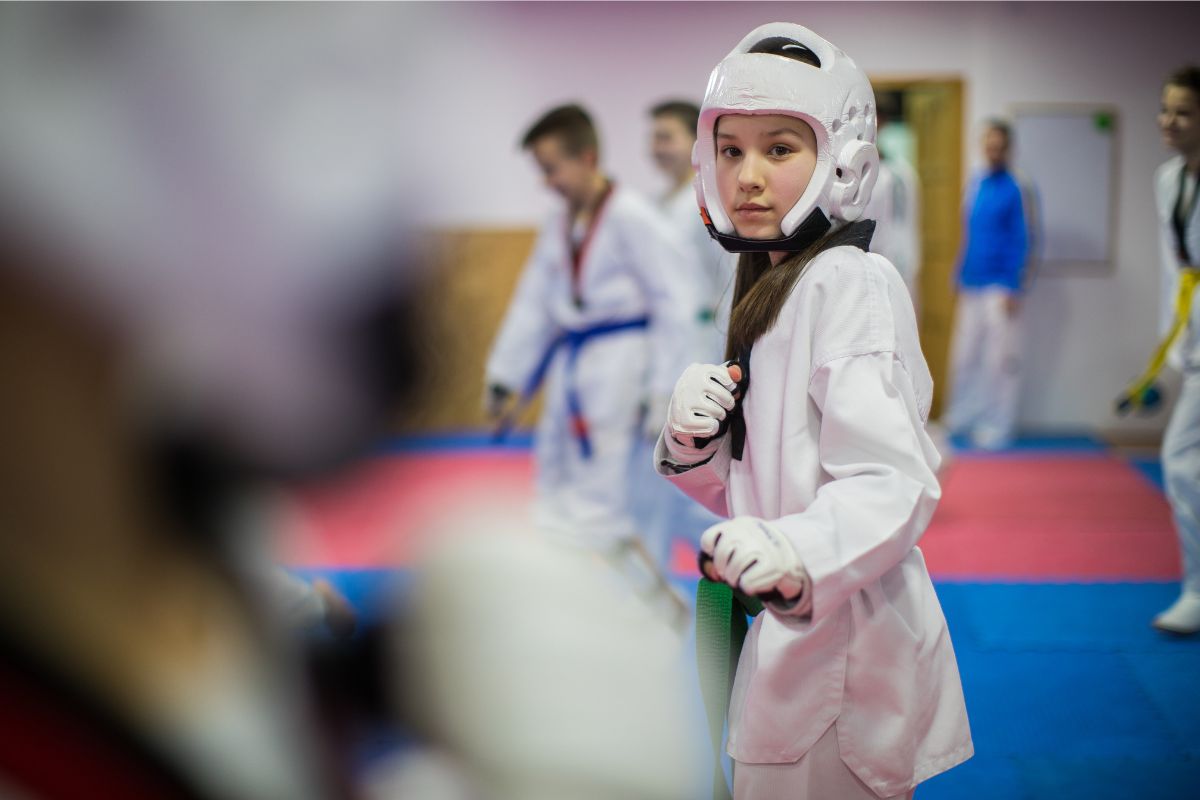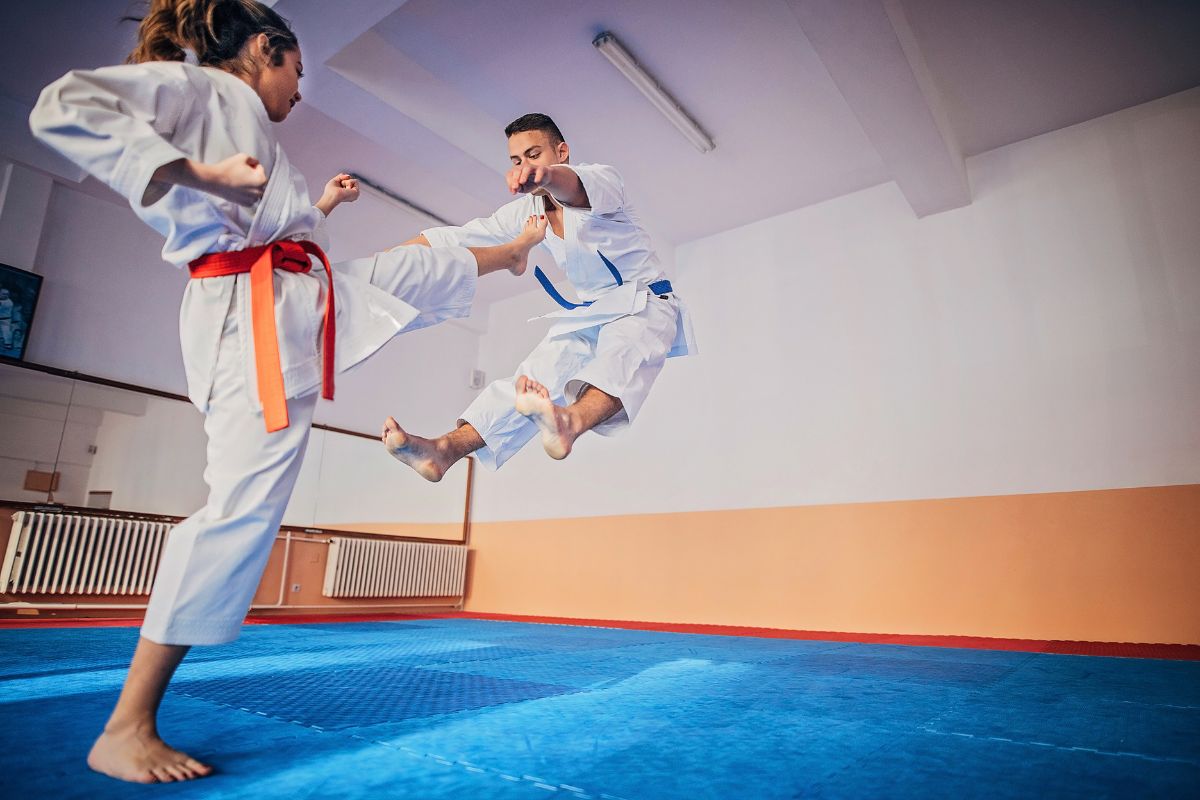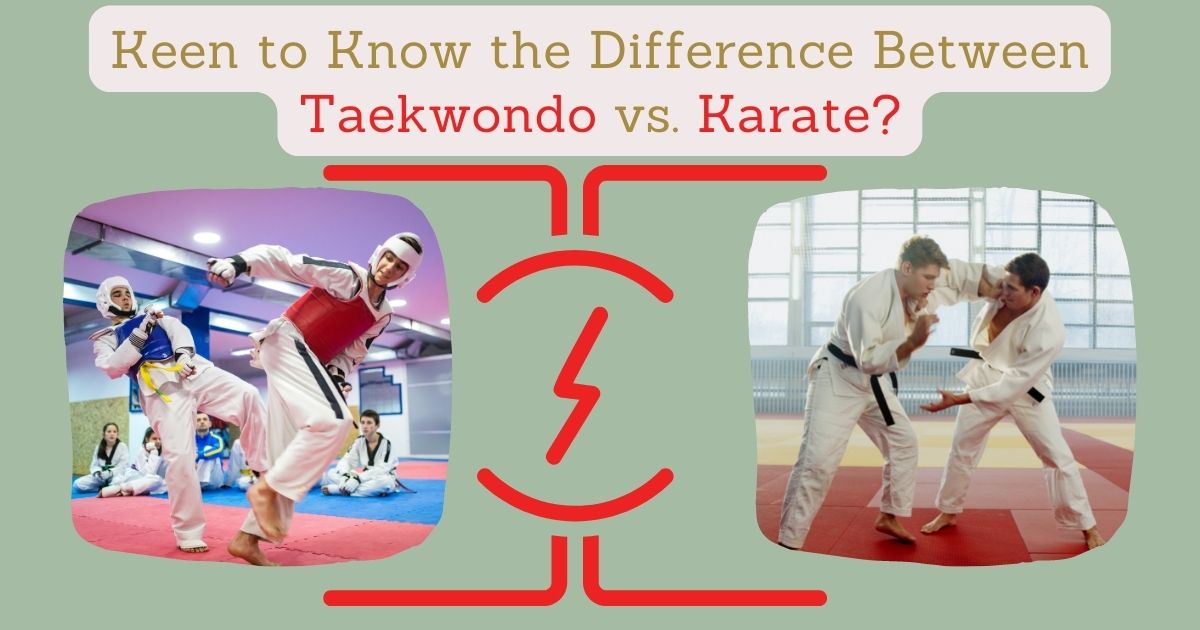Taekwondo vs. Karate
The debate on Taekwondo vs. Karate is a never-ending conversation. Both Karate and Taekwondo begin with novices learning the foundational principles and fundamental techniques. These serve as the building blocks for learning more complex movements.
You will learn many stances and techniques for punching, kicking, and blocking an opponent in Karate and Taekwondo martial arts. You will perform these carefully, holding each movement to ensure that you have the proper form.
What is Taekwondo?
If you compare it with Karate, Taekwondo features more kicking. It emphasizes kicks more and backs them up with the hands. You learn numerous kick techniques, including spinning and jumping kicks.
Legs frequently stay put in Karate since there are so many more hand attacks. In contrast, Taekwondo requires a distinct leg stance because the body must prepare to deliver quick kicks.

What is Karate?
Shuto Uchi, or the karate chop, is popular culture’s most well-known Karate move. Kicks are a backup in this combat style, which emphasizes hand tactics.

Taekwondo vs. Karate – Differences and Similarities
Karate and Taekwondo might be very similar to someone interested in martial arts. Is there a difference between Karate and Taekwondo? You can see how different they are from one another when considering their equipment, strategies, and regulations.
Based on the following characteristics, you can tell more about Taekwondo vs. Karate:
Techniques
The art of striking is how most people refer to Karate. It makes use of punching, kicking, and other open-handed motions. Joint manipulations, vital point striking, grappling, and throws are all taught in a class environment with equal focus. Kicking and hitting are two techniques you can use in Karate to defeat an opponent.
Karate requires rigorous physical training to master a series of techniques that call for mental and physical discipline. Karate, which translates to “empty hands,” is a self-defense technique that only depends on using an unarmed body.
Is Taekwondo Karate? Karate is similar to Taekwondo; however, Taekwondo is different from Karate by its widespread use of kicking techniques. The leg is a martial artist’s strongest and longest weapon, and kicks have the power to deliver significant hits, which is why this is the case.
Taekwondo improves one’s physical stamina, flexibility, balance, strength, and speed. It demonstrates concentration technique mastery and represents the fusion of one’s physical and mental disciplines.
Style/Forms
There are two ways that you can learn Taekwondo; sparring and kata. The coordinated sequence of martial arts moves known as kata, or “form,” is akin to Karate. On the other hand, Taekwondo sparring is full-contact combat where you use both attacking and defensive tactics against your opponent.
The learning system for Karate includes each one of the fundamental moves. The Three K, Kata, Kihon, and Kumite, make up this discipline. Basics, or kihon, are the foundations of fashion and the arts.
Stances, kicks, blocks, punches, and strikes are among the fundamentals of Karate. You must first repeatedly practice the Kihon fundamentals to build a solid Karate foundation. The word “kata” means “shape,” which refers to a series of coordinated motions that create a pattern you must memorize.
Speed, technique, direction, rhythm, and power are all aspects of kata training. When you examine kata at a deeper level, you can learn things that will help you defend yourself in real life. Kata is the grammar of Karate if Kihon is your vocabulary.
The last K stands for Kumite, partner work, or sparring. Working with a partner can help you learn drills that will help you become familiar with kicks, blocks, punches, and strikes.
Using these drills, you can practice your counterattacks and defensive maneuvers before using them in real-world self-defense situations. Kumite, which is how you form sentences in Karate, depends on how you use grammar and vocabulary (Kihon) (kata).
Karate competition scoring is relatively straightforward in terms of the rules. The challenger’s head, neck, face, chest, side, abdomen, and back are the only body parts exempt from it. When a practitioner employs a method that meets the requirements listed below and lands on the aforementioned body parts, they get a score:
- Proper shape
- Precise distance
- Application with vigor
- Apt timing
- Awareness
- Sporting demeanor
Attacking maneuvers can earn a fighter one, two, or three points; a Jodan kick or any other scoring maneuver you use on downing an opponent earns three points. Mid-level kicks are worth two points, and upper- or mid-level punches are for one point.
However, scoring in a Taekwondo match is extremely straightforward. You make one point for a simple strike on the opponent’s torso, two points for a spinning kick to the opponent’s torso, and three points for a kick to the head.
In major Taekwondo events, there’s the use of electronic scoring devices. You strap the device to the players’ chests and modify it to calculate the points based on the pressure they apply to the device.
When there’s no electronic scoring, panels of four judges must press a button when they observe head kicks earning points. You get the point when three judges agree on the score.
Gear
The do bok, or white uniform, is what Taekwondo practitioners wear. You can identify your rank with a colorful belt tied around your waist.
The belt comes in various hues, specifically in that order: white, yellow, green, blue, red, and finally black. When black belts gain more knowledge and experience, they get “dan” grades.
On the other hand, all Karate participants must don traditional gear, which is also plain. Karate practitioners not only have multiple belt colors to represent their rank but also stripes to show advancement within each belt color.

History
Taekwondo is a martial art that originates in Korea. It teaches techniques primarily for kicking and that, when you do it properly, it can appear almost graceful. The art teaches how to block and punch to defend against any attack, but kicking is a priority above all else.
The priority in Karate, which originates in Japan and, more specifically, Okinawa, is to strike your opponent with your hands rather than your feet. As a result, punching, kneeing, and elbow strikes are much more frequent.
The movements are quite clear and firm. There are blocking techniques similar to Taekwondo, but they also teach takedowns as a standard component of their Martial Arts training.
Philosophy
“The art (Do) of the foot (Tae) and fist” is the popular translation for Taekwondo (Kwon). The word “Do,” in Korean, refers to a philosophical approach to living one’s life and a road toward enlightenment. Taekwondo students strive to become better versions of themselves every day in class by undergoing rigorous physical, mental, and spiritual training.
The idea of Yin and Yang, which represents the interaction of opposing forces in nature, forms the core of Taekwondo. When these competing energies disperse fairly, you attain harmony and balance, providing a means of ego-detoxification.
Karate, on the other hand, is based on the Budo philosophy, the Japanese martial art ways. It is a representation in its idea of a perpetual pursuit of personal progress. “Empty Hands,” which refers to emptying the mind of all evil cravings and vanities, defines Karate.
In the martial art of Karate, the main goals are character development and physical fitness rather than winning. It calls for strict discipline and demanding workouts, just like Taekwondo.
Hands-On Activities
In Taekwondo, hand moves and punches have lost ground to kicks even more in current Taekwondo’s push to become a more sports-oriented martial art.
It tends to move away from the more traditional Taekwondo style, which uses many of the same hand forms as Karate. This is because it is difficult, if not impossible, to score with any hand technique in competitions like the Olympics.
On the other hand, Karate makes more punches and frequently incorporates knee and elbow blows. Karate punches contain motions like lunging, lunging back, jabbing, and reversing. An example of a typical and fundamental combo would be a thrust punch, followed by a back fist, an elbow strike, and so on.
Kicking
Karate vs Taekwondo: In Taekwondo, Taekwondo kicks designs are swift. They are high, efficient, and smooth—exactly what you require in a competitive environment. The roundhouse kick is the one that is common for this.
However, even among Taekwondo practitioners, there are variations in how to execute these kicks. Typical Taekwondo kicks are; the back kick, side kick, turning kick, and front kick.
Conversely, the majority of Karate kicks don’t go above the waist. The energy you require to raise the kick to this high level employs power in Karate at lower leg levels. Even though someone used to kicking high and quickly, like in Taekwondo, may find this laborious. The standard Karate kicks consist of; the front, roundhouse punch, and crescent kick with the knee.
Arms
Karate and Taekwondo appear to diverge when it comes to using weapons. Taekwondo teaches no weaponry at all, except for some ATA schools. Due to its Okinawan roots, Karate places a high priority on teaching students how to use weapons. As part of your training, you will learn how to wield weapons like the nunchaku and bo staff.
To avoid accidentally knocking yourself out, they initially have pads. Once you become more adept at using them, the “gloves come off,” and you can begin to train more intensely.
Is Taekwondo Better Than Karate?
The two best martial arts now popularly practiced are Karate and Taekwondo. They promote physical strength and excellent exercise and work well with both boys and girls. However, you must consider the points listed in this article when deciding between the two.
Is Taekwondo better than Karate? Taekwondo focuses on competition, whereas Karate focuses on self-defense. You should get knowledgeable in the one that best meets your needs.
The Origins of Karate
On the Japanese island of Okinawa, the first practice of Karate was over 500 years ago. Many claim that Karate came onto the scene when King Shoha, who was ruling then, banned the use of weapons on their island to prevent war, although there is little recorded evidence to support this.
People began using hand-to-hand combat as a form of self-defense as a result. Since the two cultures are common, Karate has influences from both China and Japan. Funakoshi Gichin, the first Karate instructor ever, was born in 1868 and chose to spend the rest of his life spreading martial arts throughout Japan.
His disciples continued where he left off right away and made the decision to form the Japan Karate Association in 1949 to advance his martial arts method.
The first Karate training facility in the United States opened its doors in 1945 and has since spread worldwide. As a martial art, it is constantly changing into several different sub-styles. The most popular distinct styles today are Wado-Ryu, Shotokan, Shito-Ryu, and Goju-Ryu.
The History of Taekwondo
Taekwondo also has a long history. This form of hand-to-hand combat existed far back in Korea in the year 50 BCE. Tae is the word for kicking, Kwon is the word for punching or destroying, and Do is the word for a method. Taekwondo is the art of using your full body to defend yourself.
Taekwondo and other martial arts training stopped working when Japan annexed Korea in the 1900s. While others traveled to Japan and China to study the arts, certain groups continued to perform it covertly. Taekwondo changed into several styles due to the introduction of Judo, Kung Fu, and Karate to Korea.
When Kwan masters gathered for a martial arts summit in 1955, the Taekwondo that we practice today was born. They combined their many martial arts forms to create a more standardized method, which they later dubbed Taekwondo.
Taekwondo vs. Karate – Which is Better for Self-Defense?
What is the difference between martial arts and Karate? Karate and Taekwondo both fall under the umbrella of martial arts. Both give you a good workout while keeping self-defense as the primary focus, and they differ very little in terms of form and ranks.
While Taekwondo emphasizes flexibility, speed, and mobility, Karate frequently emphasizes strong stances, power, and strength. Karate also often uses hand and foot techniques, whereas Taekwondo only uses kicks.
So, Taekwondo vs. Karate for self-defense, which is the best? Taekwondo focuses more on competition than self-defense, while Karate focuses more on on-street self-defense with minimal tournament preparation.
Final Thoughts
Karate vs Taekwondo, which is better? Both Karate and Taekwondo will work every muscle in your body and instill discipline and patience in their students. Depending on the specific Karate or Taekwondo style you select, they each vary significantly in how they practice.
Karate might be a better option if you’re interested in learning more coordinated, all-body techniques. Taekwondo is better if you want to acquire quick and intricate kicking techniques. Try taking introductory courses in both martial arts styles to determine which is best for you.

